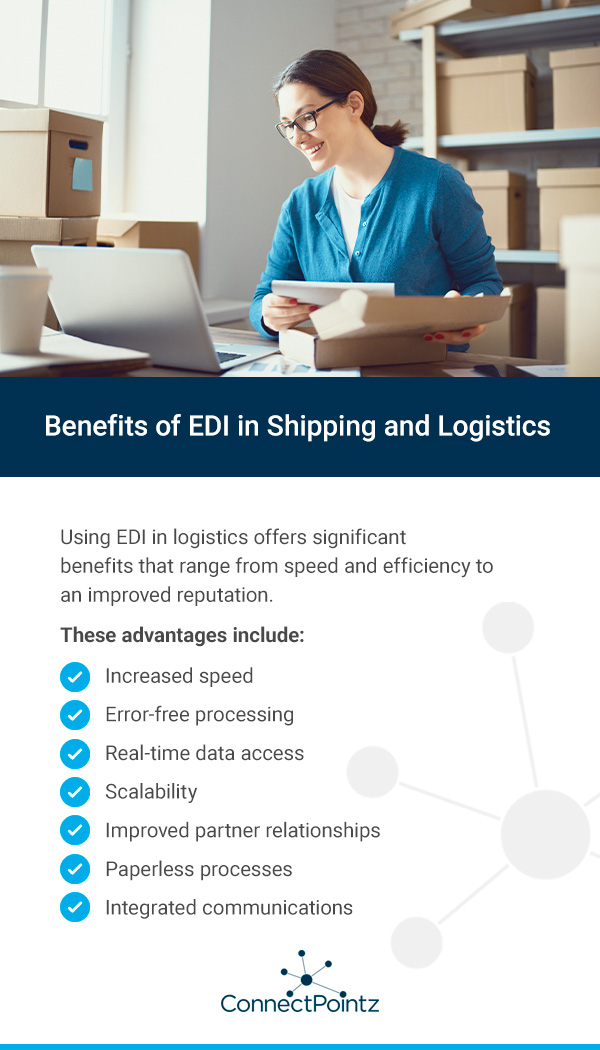What Is EDI in Shipping and Logistics?
The shipping and logistics industry handles massive amounts of data every day. Manually preparing and sharing all of that information would be virtually impossible. Electronic data interchange (EDI) offers an industrywide communication standard that allows organizations to automate data transactions, eliminating human error and streamlining business processes. Most major trading partners require EDI transactions, and failure to comply can be costly. Thankfully, EDI offers many benefits beyond compliance, helping its users stay ahead.
Let's explore EDI in logistics and shipping and how it can support your business.
What Does EDI Mean in Logistics?
EDI (Electronic Data Interchange) in logistics refers to the electronic transfer of standardized business documents between organizations. This technology enables seamless communication between supply chain partners, ensuring that critical data such as orders, invoices, and shipping notices are exchanged efficiently and accurately. In logistics, EDI streamlines operations, reduces errors, and enhances visibility across the supply chain.
How Does EDI Work in Logistics and Shipping?
EDI allows two organizations to exchange information, typically business documents, instantaneously and in a standardized format. It works in logistics and shipping as it does for other industries but focuses on relevant functions such as sending purchase orders or bills of lading. You might use it to communicate with suppliers, third-party logistics (3PL) providers, customers, port authorities and customs agencies.
EDI is crucial for keeping up with evolving demands and product movement in this fast-paced field. Working with EDI in shipping means you get insights into shipments, orders and other functions as they occur, allowing businesses to keep information updated.
If we look at what EDI stands for in logistics, we can break down its different functions:
- Electronic: Electronic communications can be facilitated in several ways, such as protocols or third-party EDI providers. Data entry often occurs automatically or through EDI-specific interfaces. The technology behind EDI varies.
- Data: The data in EDI can include a wide range of information collected in various formats. During the EDI process, this information gets standardized into a format suitable for the receiving party.
- Interchange: EDI brings different businesses and data under one umbrella, allowing organizations to communicate and providing better data visibility. The transactions happen instantaneously.
The end result is a platform that facilitates quick communications but requires accuracy and considerable setup and maintenance. As a business grows and builds its network of partners, strong and accurate EDI communication becomes essential. Below are the steps involved in creating, sending and receiving EDI transactions.
Step 1: Data Generation
Your data must come from somewhere. You might enter it manually, export information from a program or automate your document generation. You can also use application programming interfaces (APIs) to facilitate document generation from within other business applications. If you plan to take advantage of the automation capabilities of EDI, hands-off data generation is crucial.
Some examples of business documents sent via EDI include:
- Purchase orders
- Bills of lading
- Advance ship notices
- Invoices
- Shipping details
- Customs documents
- Inventory documents
At this point, the data is formatted according to the internal system. It is not EDI-ready and would not meet most requirements set by trading partners.
Step 2: EDI Translation
With the information compiled, the document gets translated into a standardized EDI format that your partners' systems can read. The United States primarily uses ANSI ASC X12 standards. European organizations use EDIFACT standards to do business. Both options include long code lists for different types of documents you might use. Communicating with an organization requires you to know which code system they use and implement it appropriately.
To map your document to these standards-based formats, you'll need EDI translation software. You could maintain this system yourself or outsource data translation to an EDI provider. Outsourced services can help with tasks like updating codes, monitoring transaction delivery and minimizing in-house hardware and software requirements. Whether you do it yourself or outsource translation, the document should be ready for sharing after this step. Information will be organized according to the code and system specified by the receiving party.
Step 3: Transaction
Now, the EDI-ready document can be sent over to the other party. This step typically happens via a secure internet protocol, such as File Transfer Protocol (FTP), Secure File Transfer Protocol (SFTP) or Applicability Statement 2 (AS2). An EDI provider can also handle this step, providing seamless connections between your organization and your partners. After receiving the document, your trading partner might feed the data into their internal systems automatically or otherwise process the information to act on it.
Let's look at an example of how these steps might be put together. EDI in logistics might start with a 3PL provider generating an advanced ship notice (ASN) to send to a retailer who will receive the shipment. The 3PL provider generates the ASN, translates it to an EDI format and sends it over to the retailer. Ideally, these transactions occur automatically, so there's no need to wait for human involvement, and the retailer can start preparing for the shipment.
Both parties enjoy fast communications that reduce lead times and help improve efficiency. Plus, the chance of error is minimal, letting them work more confidently and avoid interruptions.
Benefits of EDI in Shipping and Logistics
EDI enhances operational efficiency in logistics by automating data exchanges, which reduces the manual workload on staff and accelerates processing times.

Along with often being required for compliance with certain trading partners, using EDI in logistics offers significant benefits that range from speed and efficiency to an improved reputation. These advantages include:
- Increased speed: The shipping and logistics industries move at a breakneck pace, with items in motion at all times. Many shipments depend on immediate action to get expedited orders out the door. To keep up with these movements, communications must happen right away. EDI facilitates the fast exchange of business documents while eliminating time-consuming manual processes. It allows you to conduct business quickly, work more efficiently and stay on schedule.
- Error-free processing: Even the most attentive employees are susceptible to making errors, which are common in manual processes. EDI paves the way for automated transactions that eliminate human involvement. By removing manual entry, you can greatly reduce the chance of errors, minimizing compliance concerns and the need for costly fixes.
- Real-time data access: Shipping and logistics often call for keeping tabs on shipments and accessing up-to-date details about business processes. Since EDI happens immediately, it can help you maintain data in a centralized, updated space and make decisions based on the most recent details. It eliminates the need for manual processing that can cause documents to sit in an unprocessed state, where they can't provide necessary information.
- Scalability: Manual processes are inherently difficult to scale. If you need to increase your throughput of transactions, you would need to hire, train and manage more employees and maintain the space and equipment for them to work. Tasks like adding new partners and changing software solutions become much more complex. EDI is a scalable solution that easily accommodates increased demand, including new partners, integrations and processes. You can confidently grow your business, knowing your communication platform scales with you.
- Improved partner relationships: With reliable, error-free documentation and speedy delivery, you can establish your business as a trustworthy partner. You might gain a stronger position in negotiations and improve your relationship with various associates. An EDI solution allows you to incorporate the diverse requirements of multiple partners and work with more companies without putting compliance at risk. Standardization and automation help you meet their demands every time and boost transparency.
- Paperless processes: EDI digitizes your transactions and can help you eliminate some physical supplies, simplifying operations and saving on costs. You can reduce the need for paper, printers, ink, document storage and postage. These expenses can add up, and running out of them can cause delays. A digital solution helps you avoid these problems and impress partners with a more modern approach.
- Integrated communications: An EDI system can integrate with other business tools, like your enterprise resource planning (ERP) system and e-commerce marketplaces, so you don't need to spend time reconciling large amounts of data into different systems. An EDI also maintains a record of your business documents, providing traceability.
EDI provides a modern approach to business communications, removing slow, cumbersome processes and replacing them with immediate, error-free document transfers. While both large and small companies need EDI to work with most major trading partners, they find that a good EDI solution is an investment in many other areas of business.
The Importance of EDI Compliance in Shipping and Logistics
Many large organizations require their partners to use EDI for business communications. If your EDI transactions contain errors or don't arrive when they should, your partner may have to spend significant time and money fixing the problem. For example, a large retailer likely has automated processes in place at their shipping and receiving dock. If your ASN doesn't get sent, they have a surprise shipment to process manually, which could create bottlenecks or other interruptions that have a domino effect on other shipments and tasks.
To offset the costs of these interruptions, businesses may implement costly chargebacks or fines. If EDI compliance is a frequent problem, the retailer could even drop you as a partner. Staying compliant isn't just about making things easier for your partners — it helps ensure a good relationship with them and cost savings for you.
Poor EDI compliance can also affect your company's overall reputation. Coming back from compliance issues can be challenging, so it's especially important to start your journey into EDI with a reliable solution. You can start off strong, impress your partners and build a competitive advantage in the industry.

While it can seem difficult for small businesses to get started, EDI's meaning in logistics becomes more complex as the business grows. Once established, you can use an EDI solution to connect with more partners, expand your network and work more efficiently.
Choosing an EDI Solution in Shipping and Logistics
Logistics and shipping EDI means something different to every company that uses it. You can find EDI in various configurations and styles that reflect the characteristics of your business, such as size, partnerships and growth plans. For most businesses, an EDI partner can provide the many different technologies required for collecting and organizing data, translating documents and completing submissions. These services help ensure accuracy and efficiency from a dedicated team.
Still, not all partners are created equal. The right EDI solution for your organization — whether in-house or outsourced — depends on many factors. Consider the following elements of potential EDI partners and your business as you implement this powerful resource.
1. Business Tools
EDI documents can come from many different sources, such as an enterprise resource planning (ERP) platform or a warehouse management system (WMS). To ensure the EDI can pull data from these sources, your system must integrate with your business tools.
Consider which tools you use in your workflow, and make sure your EDI solution can connect to them. Native integrations are the simplest to use, but APIs allow you to connect to virtually all systems. If you have proprietary software, you will likely need an API to communicate with other systems.
2. Partners
Similarly, an EDI solution should offer seamless connections with the companies you do business with. From retailers to 3PL providers to shipping companies, you likely work with a wide range of partners. These connections ensure that you get direct communication with each one. An up-to-date EDI partner also helps you stay informed on any changes the partner might make to their EDI requirements, eliminating the need to monitor them yourself.
Make a list of all of your business partners to help determine your needs during implementation.
3. Scalability and Expansions
Consider your company's long-term plans. If high growth or new partners are in your future, your EDI solution must adjust accordingly. Identify potential changes to your workflow that might affect your EDI communications. Do you plan to branch out into another market and work with new retailers? Are you thinking about offering new fulfillment methods? You don't need to have a detailed roadmap, but you should make sure your EDI solution offers the flexibility to incorporate whatever partners and workflows appear.
Look for APIs and a large catalog of integrations. You may also want fast onboarding for new partners and a flexible pricing structure that allows you to pay only for what you need.
4. Data Visibility
One of EDI's most significant benefits is its ability to bring transactions under one umbrella. You might miss out on these advantages if your EDI solution is spread across multiple systems or hard to access. Make sure your solution offers extensive visibility and facilitates frequent updates between you and your partners. For example, when inventory levels change, updates should occur almost instantly, allowing you to make decisions and take action based on the most recent information.
5. Product Support
Lastly, good product support is essential. A third-party partner should offer 24/7 assistance and a strong track record of success. A reputable company can help you keep up with EDI maintenance and implement the right system for your needs. Training services can also help you use your solution more effectively.
Contact ConnectPointz for EDI Solutions
EDI is a critical component of modern shipping and logistics operations, but not all EDI systems are created equal. Set your business up for success with ConnectPointz and our industry-leading supply chain solution. We have over 180,000 pre-configured trading partner maps with global brands of all sizes. Communicate with everyone regardless of their system, stay compliant and grow your business faster.
Reach out to get a quote today and learn more about implementing EDI in your shipping and logistics operations.










































